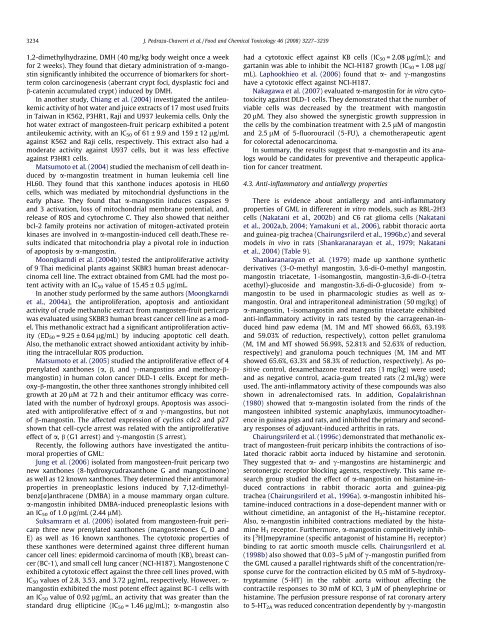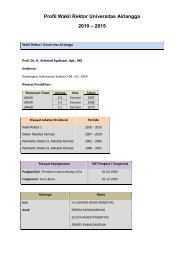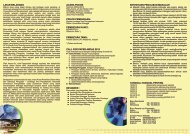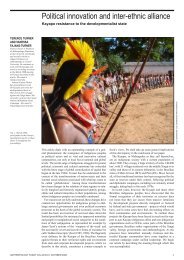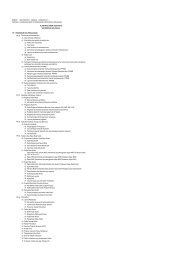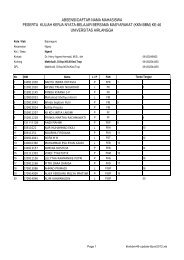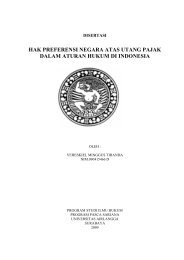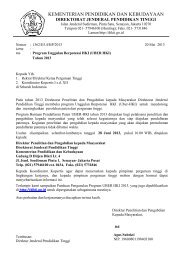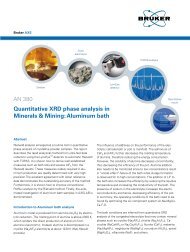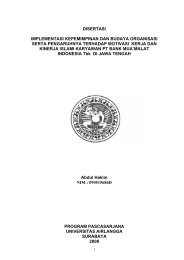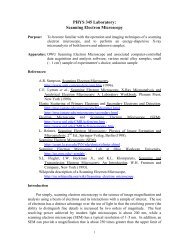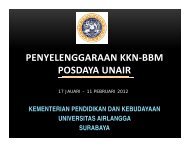Medicinal properties of mangosteen (Garcinia mangostana)
Medicinal properties of mangosteen (Garcinia mangostana)
Medicinal properties of mangosteen (Garcinia mangostana)
Create successful ePaper yourself
Turn your PDF publications into a flip-book with our unique Google optimized e-Paper software.
3234 J. Pedraza-Chaverri et al. / Food and Chemical Toxicology 46 (2008) 3227–3239<br />
1,2-dimethylhydrazine, DMH (40 mg/kg body weight once a week<br />
for 2 weeks). They found that dietary administration <strong>of</strong> a-mangostin<br />
significantly inhibited the occurrence <strong>of</strong> biomarkers for shortterm<br />
colon carcinogenesis (aberrant crypt foci, dysplastic foci and<br />
b-catenin accumulated crypt) induced by DMH.<br />
In another study, Chiang et al. (2004) investigated the antileukemic<br />
activity <strong>of</strong> hot water and juice extracts <strong>of</strong> 17 most used fruits<br />
in Taiwan in K562, P3HR1, Raji and U937 leukemia cells. Only the<br />
hot water extract <strong>of</strong> <strong>mangosteen</strong>-fruit pericarp exhibited a potent<br />
antileukemic activity, with an IC 50 <strong>of</strong> 61 ± 9.9 and 159 ± 12 lg/mL<br />
against K562 and Raji cells, respectively. This extract also had a<br />
moderate activity against U937 cells, but it was less effective<br />
against P3HR1 cells.<br />
Matsumoto et al. (2004) studied the mechanism <strong>of</strong> cell death induced<br />
by a-mangostin treatment in human leukemia cell line<br />
HL60. They found that this xanthone induces apotosis in HL60<br />
cells, which was mediated by mitochondrial dysfunctions in the<br />
early phase. They found that a-mangostin induces caspases 9<br />
and 3 activation, loss <strong>of</strong> mitochondrial membrane potential, and,<br />
release <strong>of</strong> ROS and cytochrome C. They also showed that neither<br />
bcl-2 family proteins nor activation <strong>of</strong> mitogen-activated protein<br />
kinases are involved in a-mangostin-induced cell death.These results<br />
indicated that mitochondria play a pivotal role in induction<br />
<strong>of</strong> apoptosis by a-mangostin.<br />
Moongkarndi et al. (2004b) tested the antiproliferative activity<br />
<strong>of</strong> 9 Thai medicinal plants against SKBR3 human breast adenocarcinoma<br />
cell line. The extract obtained from GML had the most potent<br />
activity with an IC50 value <strong>of</strong> 15.45 ± 0.5 lg/mL.<br />
In another study performed by the same authors (Moongkarndi<br />
et al., 2004a), the antiproliferation, apoptosis and antioxidant<br />
activity <strong>of</strong> crude methanolic extract from mangosten-fruit pericarp<br />
was evaluated using SKBR3 human breast cancer cell line as a model.<br />
This methanolic extract had a significant antiproliferation activity<br />
(ED50 = 9.25 ± 0.64 lg/mL) by inducing apoptotic cell death.<br />
Also, the methanolic extract showed antioxidant activity by inhibiting<br />
the intracellular ROS production.<br />
Matsumoto et al. (2005) studied the antiproliferative effect <strong>of</strong> 4<br />
prenylated xanthones (a, b, and c-mangostins and methoxy-bmangostin)<br />
in human colon cancer DLD-1 cells. Except for methoxy-b-mangostin,<br />
the other three xanthones strongly inhibited cell<br />
growth at 20 lM at 72 h and their antitumor efficacy was correlated<br />
with the number <strong>of</strong> hydroxyl groups. Apoptosis was associated<br />
with antiproliferative effect <strong>of</strong> a and c-mangostins, but not<br />
<strong>of</strong> b-mangostin. The affected expression <strong>of</strong> cyclins cdc2 and p27<br />
shown that cell-cycle arrest was related with the antiproliferative<br />
effect <strong>of</strong> a, b (G1 arrest) and c-mangostin (S arrest).<br />
Recently, the following authors have investigated the antitumoral<br />
<strong>properties</strong> <strong>of</strong> GML:<br />
Jung et al. (2006) isolated from <strong>mangosteen</strong>-fruit pericarp two<br />
new xanthones (8-hydroxycudraxanthone G and mangostinone)<br />
as well as 12 known xanthones. They determined their antitumoral<br />
<strong>properties</strong> in preneoplastic lesions induced by 7,12-dimethylbenz[a]anthracene<br />
(DMBA) in a mouse mammary organ culture.<br />
a-mangostin inhibited DMBA-induced preneoplastic lesions with<br />
an IC50 <strong>of</strong> 1.0 lg/mL (2.44 lM).<br />
Suksamrarn et al. (2006) isolated from <strong>mangosteen</strong>-fruit pericarp<br />
three new prenylated xanthones (mangostenones C, D and<br />
E) as well as 16 known xanthones. The cytotoxic <strong>properties</strong> <strong>of</strong><br />
these xanthones were determined against three different human<br />
cancer cell lines: epidermoid carcinoma <strong>of</strong> mouth (KB), breast cancer<br />
(BC-1), and small cell lung cancer (NCI-H187). Mangostenone C<br />
exhibited a cytotoxic effect against the three cell lines proved, with<br />
IC50 values <strong>of</strong> 2.8, 3.53, and 3.72 lg/mL, respectively. However, amangostin<br />
exhibited the most potent effect against BC-1 cells with<br />
an IC50 value <strong>of</strong> 0.92 lg/mL, an activity that was greater than the<br />
standard drug ellipticine (IC 50 = 1.46 lg/mL); a-mangostin also<br />
had a cytotoxic effect against KB cells (IC50 = 2.08 lg/mL); and<br />
gartanin was able to inhibit the NCI-H187 growth (IC 50 = 1.08 lg/<br />
mL). Laphookhieo et al. (2006) found that a- and c-mangostins<br />
have a cytotoxic effect against NCI-H187.<br />
Nakagawa et al. (2007) evaluated a-mangostin for in vitro cytotoxicity<br />
against DLD-1 cells. They demonstrated that the number <strong>of</strong><br />
viable cells was decreased by the treatment with mangostin<br />
20 lM. They also showed the synergistic growth suppression in<br />
the cells by the combination treatment with 2.5 lM <strong>of</strong> mangostin<br />
and 2.5 lM <strong>of</strong> 5-fluorouracil (5-FU), a chemotherapeutic agent<br />
for colorectal adenocarcinoma.<br />
In summary, the results suggest that a-mangostin and its analogs<br />
would be candidates for preventive and therapeutic application<br />
for cancer treatment.<br />
4.3. Anti-inflammatory and antiallergy <strong>properties</strong><br />
There is evidence about antiallergy and anti-inflammatory<br />
<strong>properties</strong> <strong>of</strong> GML in differerent in vitro models, such as RBL-2H3<br />
cells (Nakatani et al., 2002b) and C6 rat glioma cells (Nakatani<br />
et al., 2002a,b, 2004; Yamakuni et al., 2006), rabbit thoracic aorta<br />
and guinea-pig trachea (Chairungsrilerd et al., 1996b,c) and several<br />
models in vivo in rats (Shankaranarayan et al., 1979; Nakatani<br />
et al., 2004) (Table 9).<br />
Shankaranarayan et al. (1979) made up xanthone synthetic<br />
derivatives (3-O-methyl mangostin, 3,6-di-O-methyl mangostin,<br />
mangostin triacetate, 1-isomangostin, mangostin-3,6-di-O-(tetra<br />
acethyl)-glucoside and mangostin-3,6-di-O-glucoside) from amangostin<br />
to be used in pharmacologic studies as well as amangostin.<br />
Oral and intraperitoneal administration (50 mg/kg) <strong>of</strong><br />
a-mangostin, 1-isomangostin and mangostin triacetate exhibited<br />
anti-inflammatory activity in rats tested by the carrageenan-induced<br />
hind paw edema (M, 1M and MT showed 66.6%, 63.19%<br />
and 59.03% <strong>of</strong> reduction, respectively), cotton pellet granuloma<br />
(M, 1M and MT showed 56.99%, 52.81% and 52.63% <strong>of</strong> reduction,<br />
respectively) and granuloma pouch techniques (M, 1M and MT<br />
showed 65.6%, 63.3% and 58.3% <strong>of</strong> reduction, respectively). As positive<br />
control, dexamethazone treated rats (1 mg/kg) were used;<br />
and as negative control, acacia-gum treated rats (2 mL/kg) were<br />
used. The anti-inflammatory activity <strong>of</strong> these compounds was also<br />
shown in adrenalectomised rats. In addition, Gopalakrishnan<br />
(1980) showed that a-mangostin isolated from the rinds <strong>of</strong> the<br />
<strong>mangosteen</strong> inhibited systemic anaphylaxis, immunocytoadherence<br />
in guinea pigs and rats, and inhibited the primary and secondary<br />
responses <strong>of</strong> adjuvant-induced arthritis in rats.<br />
Chairungsrilerd et al. (1996c) demonstrated that methanolic extract<br />
<strong>of</strong> <strong>mangosteen</strong>-fruit pericarp inhibits the contractions <strong>of</strong> isolated<br />
thoracic rabbit aorta induced by histamine and serotonin.<br />
They suggested that a- and c-mangostins are histaminergic and<br />
serotonergic receptor blocking agents, respectively. This same research<br />
group studied the effect <strong>of</strong> a-mangostin on histamine-induced<br />
contractions in rabbit thoracic aorta and guinea-pig<br />
trachea (Chairungsrilerd et al., 1996a). a-mangostin inhibited histamine-induced<br />
contractions in a dose-dependent manner with or<br />
without cimetidine, an antagonist <strong>of</strong> the H2-histamine receptor.<br />
Also, a-mangostin inhibited contractions mediated by the histamine<br />
H1 receptor. Furthermore, a-mangostin competitively inhibits<br />
[ 3 H]mepyramine (specific antagonist <strong>of</strong> histamine H 1 receptor)<br />
binding to rat aortic smooth muscle cells. Chairungsrilerd et al.<br />
(1998b) also showed that 0.03–5 lM <strong>of</strong>c-mangostin purified from<br />
the GML caused a parallel rightwards shift <strong>of</strong> the concentration/response<br />
curve for the contraction elicited by 0.5 mM <strong>of</strong> 5-hydroxytryptamine<br />
(5-HT) in the rabbit aorta without affecting the<br />
contractile responses to 30 mM <strong>of</strong> KCl, 3 lM <strong>of</strong> phenylephrine or<br />
histamine. The perfusion pressure response <strong>of</strong> rat coronary artery<br />
to 5-HT 2A was reduced concentration dependently by c-mangostin


